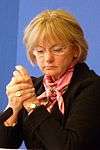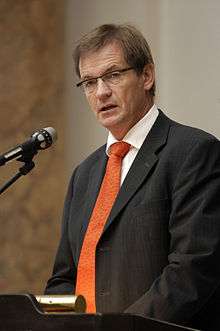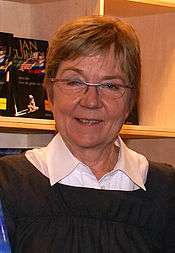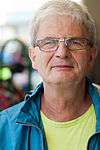Danish general election, 2005
| | ||||||||||||||||||||||||||||||||||||||||||||||||||||||||||||||||||||||||||||||||||||||||||||||||||||||||||||||||||||||||||
| ||||||||||||||||||||||||||||||||||||||||||||||||||||||||||||||||||||||||||||||||||||||||||||||||||||||||||||||||||||||||||
| ||||||||||||||||||||||||||||||||||||||||||||||||||||||||||||||||||||||||||||||||||||||||||||||||||||||||||||||||||||||||||
| ||||||||||||||||||||||||||||||||||||||||||||||||||||||||||||||||||||||||||||||||||||||||||||||||||||||||||||||||||||||||||
General elections were held in Denmark on 8 February 2005.[1] Prime Minister Anders Fogh Rasmussen's Venstre retained the largest number of seats in parliament. The governing coalition between the Venstre and the Conservative People's Party remained intact, with the Danish People's Party providing the parliamentary support needed for the minority government. The Danish Social Liberal Party made the biggest gains of any party, although it remains outside the governing group of parties. The election marked the second time in a row that the Social Democrats were not the largest party in the parliament, a change from most of the 20th century. The party lost 5 seats and leader Mogens Lykketoft resigned immediately after the election.
The prime minister called the elections on 18 January. He claimed that he would have called it earlier, but the 2004 Indian Ocean earthquake which killed a number of Danes delayed it. Rasmussen still had almost a year left in his term, but said he wanted to call the election before municipal elections in November. His reasoning was that he wanted a clear mandate for the municipal and county government restructuring that his government was implementing.
From the last election the governing coalition of Venstre and the Conservative People's Party had 94 of the 175 seats together with the supporting Danish People's Party. This number was unchanged after the 2005 election. Voter turnout was 84.5% in Denmark proper, 73.0% in the Faroe Islands and 59.4% in Greenland.[2]
Results
| Denmark | ||||
|---|---|---|---|---|
| Party | Votes | % | Seats | +/– |
| Venstre | 974,636 | 29.0 | 52 | –4 |
| Social Democratic Party | 867,349 | 25.8 | 47 | –5 |
| Danish People's Party | 444,947 | 13.3 | 24 | +2 |
| Conservative People's Party | 344,886 | 10.3 | 18 | +2 |
| Danish Social Liberal Party | 308,212 | 9.2 | 17 | +8 |
| Socialist People's Party | 201,047 | 6.0 | 11 | –1 |
| Red-Green Alliance | 114,123 | 3.4 | 6 | +2 |
| Christian Democrats | 58,071 | 1.7 | 0 | –4 |
| Centre Democrats | 33,880 | 1.0 | 0 | ±0 |
| Minority Party | 8,850 | 0.3 | 0 | New |
| Independents | 1,211 | 0.0 | 0 | ±0 |
| Invalid/blank votes | 27,348 | – | – | – |
| Total | 3,384,560 | 100 | 175 | 0 |
| Faroe Islands | ||||
| Republican Party | 6,301 | 25.4 | 1 | ±0 |
| People's Party | 5,967 | 24.0 | 1 | +1 |
| Social Democratic Party | 5,518 | 22.2 | 0 | ±0 |
| Union Party | 5,333 | 21.5 | 0 | –1 |
| Centre Party | 829 | 3.3 | 0 | New |
| Self-Government Party | 585 | 2.4 | 0 | ±0 |
| Independents | 309 | 1.2 | 0 | New |
| Invalid/blank votes | 94 | – | – | – |
| Total | 24,936 | 100 | 2 | 0 |
| Greenland | ||||
| Forward | 7,761 | 34.3 | 1 | ±0 |
| Inuit Ataqatigiit | 5,774 | 25.5 | 1 | 0 |
| Democrats | 4,909 | 21.7 | 0 | New |
| Feeling of Community | 3,374 | 14.9 | 0 | ±0 |
| Independents | 841 | 3.7 | 0 | ±0 |
| Invalid/blank votes | 457 | – | – | – |
| Total | 23,516 | 100 | 2 | 0 |
| Source: Nohlen & Stöver | ||||
63 out of the 179 members of the new folketing are newly elected. Although women make up 38% of the total, several women hold prominent positions, notably Pia Kjærsgaard, leader of the third largest party, Danish People's Party. Marianne Jelved (leader of the Danish Social Liberal Party), Connie Hedegaard (Minister of the Environment), Pernille Rosenkrantz-Theil (front figure of Enhedslisten) and Helle Thorning-Schmidt (later elected as leader of Social Democrats) are other important woman in the parliament. A couple of parties, including the Social Democrats are holding leadership races, which may be won by women. 9 of the top 20 candidates, in terms of personal votes, were women.
Following the election, Prime Minister Anders Fogh Rasmussen reformed his liberal-conservative cabinet as the Cabinet of Anders Fogh Rasmussen II with parliamentary support from Danish People's Party.
Platforms
Venstre, the party of the prime minister, campaigned on their municipal restructuring plan, as well as a continuation of the "tax-freeze" and tight immigration requirements. They also promised to see 60,000 jobs created during a second term.
The largest opposition party, the Social Democrats led by Mogens Lykketoft focused on employment, which they claim has decreased under the current government.
The Danish People's Party, who support the Venstre-Conservative coalition, criticized the "tax-freeze" but agreed, conditionally, to support it for another parliamentary term. They also wanted increasingly tough immigration restrictions.
References
Further reading
- Pedersen, Karina (November 2005). "The 2005 Danish general election: A phase of consolidation". West European Politics. 28 (5): 1101–1108. doi:10.1080/01402380500311848.






